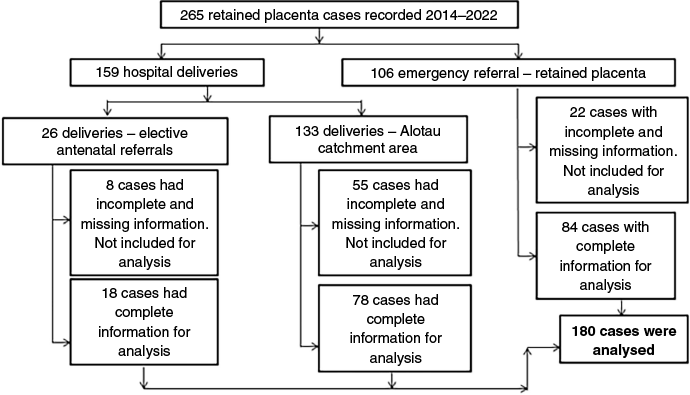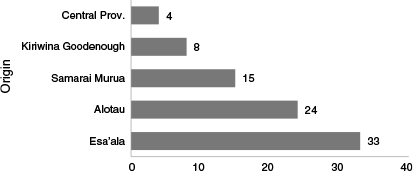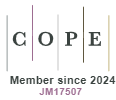Management and outcomes of retained placenta at a provincial hospital in Papua New Guinea: a retrospective observational study
John Kukiti A , Ian Umo B * , Alice Siwawata A , Rodney Talo A and Grace Kariwiga AA
B
Abstract
Retained placenta is a significant cause of postpartum haemorrhage and is a major contributor to maternal death. It is defined as the retention of the placenta 30 min after the delivery of a foetus. Milne Bay Province contributes to the high maternal mortality rate of Papua New Guinea. Between 2014 and 2022, 35% of maternal deaths at the Alotau Provincial Hospital were due to retained placenta. This study aims to describe the management and outcomes of mothers presenting with retained placenta to the Alotau Provincial Hospital.
This was a retrospective study conducted over 8 years to investigate the management outcomes of retained placenta in a provincial hospital of Papua New Guinea.
A total of 13,731 deliveries took place at the Alotau Provincial Hospital between 1 January 2014 and 31 December 2022. The incidence rate of retained placenta was 1.9%. Complete data were available for 180 of these cases, and they were analysed further. Active management of the third stage of labour was performed in 128 cases (71%). Manual removal of the placenta without anaesthesia in the hospital’s labour ward was successful in 51% of cases. The duration of the third stage ranged from 30 min to 16 days, with 45% (n = 82) of cases resolving within an hour. Postpartum haemorrhage occurred in 69% (n = 124) of cases, while 51% (n = 63) of patients experienced severe postpartum haemorrhage and hypovolemic shock. The sepsis rate was 20% (n = 36), and the maternal mortality rate was 0.6%.
This study highlights the substantial burden of retained placenta at the Alotau Provincial Hospital. Despite an increase in supervised deliveries, most emergency cases of retained placenta stem from unsupervised village births, often complicated by postpartum haemorrhage.
Keywords: Alotau Provincial Hospital, maternal mortality, Milne Bay Province, Papua New Guinea, postpartum haemorrhage, retained placenta, supervised delivery, unsupervised village birth.
Introduction
Retained placenta is defined as a placenta that has not been expelled 30 min post-delivery.1 It affects 0.5–3% of deliveries globally and is considered one of the most common causes of postpartum haemorrhage (PPH), which is the most common cause of maternal death in developing nations.2
The maternal mortality rate of Papua New Guinea (PNG) was reported to be 171 per 100,000 live births, with the Milne Bay Province (MBP) having one of the highest maternal mortality rates in the country.3,4 Efforts such as the birth incentivisation and building of waiting houses for mothers have increased the number of supervised deliveries and improved maternal outcomes over the last 5 years.5
According to the Alotau Provincial Hospital (APH) maternal death registry (years 2014–2022), 35% (n = 57) of all the maternal deaths registered were due to retained placenta. Barss and Misch published a prospective study in MBP on retained placenta in 1989 and found the incidence rate to be 3 per 1000 live births.5 Furthermore, in 2011, a verbal autopsy of maternal deaths in MBP reported 30% of cases were as a result of retained placenta.6
The data on this topic within PNG and MBP is now outdated. As such, the aim of this study was to describe the management and outcomes of women more recently presenting with retained placenta to APH.
Materials and methods
Study design
This was a retrospective study covering a period of 8 years from 1 January 2014 to 31 December 2022.
Study setting
This study was conducted at APH in MBP of PNG. APH serves as the only referral hospital in the province and provides safe anaesthesia and surgery for a population of 150,000 people. APH has a birth rate of 1400 births annually, with approximately 50% of births being referrals.
The primary obstetrics services are provided by 25 midwives who work in various health centres in MBP. The Obstetrics and Gynaecology department of APH has three functional wards comprising the labour ward, antenatal ward and the postnatal ward. Together, these wards have a bed capacity of 60. The department has two obstetrician and gynaecologists, two registrars and a clinical health extension officer.
Participants
The study included cases of retained placenta delivered at APH and those referred for retained placenta from health facilities in MBP. Cases excluded were caesarean sections with adherent placenta and cases of retained placenta managed successfully outside of APH.
Data collection and variables
Data and other variables were collected from the labour ward birth registry book, operative registry books and the admission books from 1 January 2014 to 31 December 2022. These were used to obtain the case files from the medical records. Information extracted includes socio-demographic characteristics (age, parity, referral locations), gestation, types of delivery, mode of management and the outcomes.
Management and outcome
The third stage of labour refers to the period between the delivery of the baby and the complete expulsion of the placenta and membranes from the uterus. This stage typically lasts 5–30 min and involves uterine contractions that help separate and expel the placenta. Active management of the third stage of labour is used to reduce the risk of PPH and includes:7
administration of a uterotonic drug (e.g. oxytocin) immediately after the birth of the baby,
controlled cord traction to assist in delivering the placenta,
uterine massage after the placenta is delivered to promote uterine contraction and reduce bleeding.
The primary outcomes were a composite of the length of third stage and PPH. PPH is defined as blood loss of ≥500 mL within 24 h of giving birth.7 The secondary outcomes were haemoglobin levels, admissions and near-misses. The haemoglobin ranges in pregnancy were categorised as normal (>10 g/dL), mild anaemia (7–9.9 g/dL), moderate anaemia (5–6.9 g/dL) and severe anaemia (1–4.9 g/dL).8
A supervised birth was defined in this study as birth in a health facility under the supervision of a skilled birth attendant that could be either a nursing officer, health extension officer or a medical officer.9 Booked mothers were defined according to the World Health Organization (WHO) criteria for low- to middle-income countries as those with at least four antenatal visits, with the first being in trimester one.10
Results
There was a total of 13,731 deliveries at APH from 1 January 2014 to 31 December 2022. Of the total cohort, there were 265 cases of retained placenta with an incidence rate of 1.9%. A total of 180 cases of retained placenta with complete data were analysed in this study as shown in Fig. 1.
The breakdown of retained placenta cases from 1 January 2014 to 31 December 2022 at Alotau Provincial Hospital.

The socio-demographic characteristics are shown in Table 1. The mean age was 29.3 years. Most mothers (80%, n = 144) were booked at the antenatal clinic. The mean parity was three. Grandmultiparity accounted for 26% (n = 47) of all the retained placenta. Hospital deliveries accounted for 44% (n = 78) of retained placenta cases, with most (92%) of the pregnancies delivered at term. The majority of emergency cases were referred from the Esa’ala district (39%, n = 33) as shown in Fig. 2. Supervised deliveries accounted for the majority of cases (71%, n = 128) as shown in Fig. 3.
| Characteristics | Number (%) | |
|---|---|---|
| Age | ||
| <19 years | 20 (11) | |
| 20–34 years | 109 (61) | |
| >35 years | 51 (28) | |
| Parity | ||
| 1 | 53 (29) | |
| 2–4 | 80 (44) | |
| >5 | 47 (27) | |
| Referral | ||
| Yes | 84 (47) | |
| No | 96 (53) | |
| Booked | ||
| Yes | 144 (80) | |
| No | 36 (20) | |
| Term (37 completed weeks) | ||
| Yes | 166 (92) | |
| No | 14 (8) | |
| Grandmultiparity (>5 births at >20 weeks gestation) | ||
| Yes | 47 (26) | |
| No | 133 (74) | |
| APH delivery | ||
| Yes | 78 (43) | |
| No | 102 (57) | |
| Gestational age at delivery | ||
| ≥37 weeks (term) | 166 (92) | |
| <37 weeks | 14 (8) | |
Emergency referrals of retained placenta cases to the Alotau Provincial Hospital from five districts (from 1 January 2014 to 31 December 2022).

Supervised and unsupervised deliveries of retained placenta cases from 1 January 2014 to 31 December 2022 at Alotau Provincial Hospital. BBA, birth before arrival.

The management of retained placenta at APH is summarised in Table 2. Active third stage management (ATSM) was performed in 128 cases (71%). Among the total cohort, 8% (n = 14) experienced retained placenta for more than 2 days, primarily due to travel delays caused by weather conditions and fuel shortages. The longest case of retained placenta lasted 16 days in an unbooked mother referred from Sehulea Health Centre. In this instance, fuel shortages delayed travel, and upon arrival, the mother was anaemic and required a blood transfusion, which was further delayed due to limited blood availability at APH. Despite these challenges, she recovered and was successfully discharged. Manual removal of placenta (MROP) without anaesthesia in the hospital’s labour ward was successful in 51% (n = 92) of cases. Antibiotics were administered in 73% (n = 132) of cases, while 41% (n = 73) of patients required blood transfusions.
| Post-delivery interventions | Number (%) | |
|---|---|---|
| Active third stage management | ||
| Yes | 128 (71) | |
| No | 52 (29) | |
| Delivery of placenta | ||
| MROP in labour ward | 93 (51) | |
| MROP in the operating theatre | 74 (41) | |
| TAH/STAH | 10 (6) | |
| Spontaneous expulsion | 3 (2) | |
| Antibiotics | ||
| Yes | 132 (73) | |
| No | 48 (27) | |
| Blood transfusion | ||
| Yes | 73 (41) | |
| No | 107 (59) | |
Abbreviations: MROP, manual removal of placenta; TAH, total abdominal hysterectomy; STAH, subtotal abdominal hysterectomy.
The length of third stage ranges from 30 min to 16 days. The third stage period of less than an hour occurred in 45% (n = 82) of cases as shown in Table 3. PPH occurred in 69% (n = 124) of cases. More than half of the patients developed severe PPH (blood loss ≥1000 mL) and hypovolemic shock. The sepsis rate was 20% (n = 36) and the maternal mortality rate was 0.6%. The one maternal death was in an unbooked mother, who had an unsupervised delivery at Guasopa Health Centre and had to travel 300 km by boat to APH. The death was a result of sepsis.
| Characteristics | Number (%) | |
|---|---|---|
| Primary outcomes | ||
| Length of third stage | ||
| 30 min–1 h | 82 (45) | |
| >1 h–24 h | 59 (33) | |
| >24 h–48 h | 25 (14) | |
| >48 h–16 days | 14 (8) | |
| Postpartum haemorrhage | ||
| Yes | 124 (69) | |
| No | 56 (31) | |
| Secondary outcomes | ||
| Haemoglobin level (g/dL) | ||
| ≥10 | 36 (20) | |
| 7–9.9 | 37 (21) | |
| 5–6.9 | 23 (13) | |
| 1–4.9 | 42 (23) | |
| No results | 42 (23) | |
| Admission | ||
| Ward 2 | 174 (97) | |
| Intensive care unit | 6 (3) | |
| Near-miss | ||
| Yes | 63 (35) | |
| No | 117 (65) | |
| Maternal death | ||
| Yes | 1 (1) | |
| No | 179 (99) | |
Maternal near-miss accounted for 35% (n = 63) of retained placenta cases. Of the near-misses, two deliveries were supervised at APH. The others were all emergency referrals into APH, with 68.3% (n = 43) of mothers having had an unsupervised delivery. Haemorrhagic shock was the main complication occurring in 63% (n = 40) of near-misses of which 10 patients had to undergo a hysterectomy.
Discussion
This study reports the management and outcomes of mothers with retained placenta presenting to APH over a period of 8 years. The mean age of women in this study was 29.3 years. In PNG, women more than the age of 30 years were significantly associated with maternal near-miss.11 Most women in this study were from the Esa’ala district, a finding that was also reported by Mola and Kirby who looked at maternal mortality in PNG.4
The PNG Demographic and Health Survey (2016–2018) reported a total antenatal coverage of 92.9% for the MBP.3 In our study, antenatal coverage for patients with retained placenta was 80%, with a higher proportion of unbooked mothers. Supervised deliveries among retained placenta cases were 71%, closely aligning with the national survey’s reported rate of 71.2%. These findings indicate a significant increase in supervised births from 51.2% in 2013.3
The management of retained placenta begins immediately after foetal delivery. In all supervised deliveries, ATSM was administered, while unsupervised deliveries lacked this intervention. The use of oxytocin in ATSM plays a crucial role in preventing retained placenta and PPH, making it especially vital in resource-limited settings.12
Almost all the emergency referrals were maternal near-misses due to haemorrhagic shock, sepsis and associated multi-organ failure. The criteria used for maternal near-miss was the Port Moresby General Hospital adaptation criteria derived from the WHO criteria.13 Antibiotic recommendation requires at least a single dose of cephalosporin for all MROP procedures due to the high risk of septicaemia.14 Patients in this study, with retained placenta ≥24 h, were given ceftriaxone, metronidazole and gentamycin. Patients with retention of less than 1 h were given at least a single dose of ceftriaxone or oral amoxicillin.
The lengths of third stage labour were shorter in hospital deliveries where MROP was done successfully by experienced midwives and doctors. In contrast, emergency referrals were often a result of unsuccessful MROP by inexperienced health workers. The delays in management were further compounded by logistical issues, distance and weather conditions.
In this study, pre-hospital PPH was linked to significant maternal morbidity. Half of the cases progressed to haemorrhagic shock at health centres without blood transfusion capabilities. Additionally, one-third of patients with retained placenta were classified as near-miss cases, presenting with severe anaemia and sepsis.
The retrospective design of the study resulted in a significant amount of missing and incomplete data. This resulted in 108 cases being excluded due to insufficient information. Nevertheless, the objectives of the study were achieved and recommendations could be formulated.
Addressing retained placenta and its associated morbidity can be significantly improved by strengthening district hospitals and enhancing the skills of community health workers (CHWs) in emergency obstetric care. Lokuge et al. reported that up skilling CHWs is feasible in PNG with positive outcomes for maternal care.15 Improved implementation and advocacy for family planning will also reduce this burden. District hospitals must also enhance their pathology services to ensure timely transfusion of anaemic women awaiting definitive management.
Conclusion
This study highlights the substantial burden of retained placenta at the Alotau Provincial Hospital. Despite an increase in supervised deliveries, most emergency cases of retained placenta stem from unsupervised village births, often complicated by postpartum haemorrhage. It is thus imperative that we support and upskill community healthcare workers with midwifery skills to better manage mothers with retained placentas at the peripheral health centres.
Data availability
The data that supports the findings of this study are available from the corresponding author upon request.
References
1 Cheung WM, Hawkes A, Ibish S, Weeks AD. The retained placenta: historical and geographical rate variations. J Obstet Gynecol 2011; 31(1): 37-42.
| Crossref | Google Scholar | PubMed |
2 GBD 2015 Maternal Mortality Collaborators. Global, regional, and national levels of maternal mortality, 1990-2015: a systematic analysis for the global burden of disease study 2015. Lancet 2016; 388: 1775-812.
| Crossref | Google Scholar | PubMed |
4 Mola G, Kirby B. Discrepancies between national maternal mortality data and international estimates: the experience of Papua New Guinea. Reprod Health Matters 2013; 21: 191-202.
| Crossref | Google Scholar | PubMed |
5 Barss P, Misch KA. Endemic placenta accreta in a population of remote villagers in Papua New Guinea. Br J Obstet Gynaecol 1989; 97: 167-74.
| Crossref | Google Scholar |
9 Ganle JK, Kombet ML, Baatiema L. Factors influencing the use of supervised delivery services in Garu-Tempane District, Ghana. BMC Pregnancy Childbirth 2019; 19: 141.
| Crossref | Google Scholar | PubMed |
11 Bolnga J, Morris M, Totona C, Laman M. Maternal near-misses at a provincial hospital in Papua New Guinea: A prospective observational study. Aust N Z J Obstet Gynaecol 2017; 57: 624-9.
| Crossref | Google Scholar | PubMed |
12 Weeks A, Mirembe F, Alfirevic Z. The Release Trial: a randomised controlled trial of umbilical vein oxytocin versus placebo for the treatment of retained placenta. BJOG 2005; 112: 1458.
| Crossref | Google Scholar |
13 Tanimia H, Jayaratnam S, Mola GL, Amoa AB, de Costa C. Near-misses at the Port Moresby General Hospital: a descriptive study. Aust N Z J Obstet Gynaecol 2016; 56: 148-53.
| Crossref | Google Scholar | PubMed |
15 Lokuge K, Wemin F, Joshy G, Dl Mola G. Evaluation of an obstetric and neonatal care up skilling program for community health workers in Papua New Guinea. BMC Pregnancy Childbirth 2024; 24: 357.
| Crossref | Google Scholar | PubMed |


